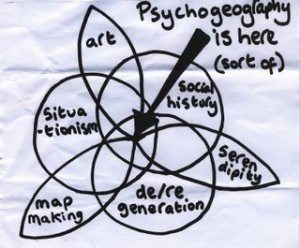I was delighted to be asked to talk at the Sunday Assembly. And possibly a little flattered at the invitation, which meant I said yes more eagerly than I should have done, particularly when the subject was something as contentious as ‘psychogeography’.
I’ve given talks on this before, at the Catalyst Club and White Night, and they were well received. But I didn’t want to give that same talk again. One issue was the slightly unfashionable reputation psychogeography has developed, such that many practitioners disavow the term. I also hated the idea of another talk where a middle-aged man explains things, with slides, about things other men have done. So I decided to take a different route through psychogeography that I normally would.
I’ve had a number of friends who’ve talked about representation in art to me, particularly Kate Shields. I wondered if I could give the talk without hitting the usual litany of names – Guy deBord – Iain Sinclair – Richard Long. What if I gave the talk without saying any men’s names, focusing on art by women? My aim with this was not virtue signalling – but I needed to find a way to make this subject fresh for me.
At first I worried that this constraint would ruin the talk – where would I find the resources to do this? But then there was Amy Sharrock’s response to Iain Sinclair saying there were no women doing art around walking: “male artists and curators have a responsibility from their positions of power to do better research, as do we all.”
And that research was not so difficult. There are many women who have done art relating to walking, and books such as Walking and Mapping by O’Rouke have even done the work of collecting these. Tina Richardson’s recent book about contemporary British psychogeography has some other examples. And there are some excellent papers on women walking artists by Dee Heddon and Cathy Turner.
The talk soon opened out. The subject felt more excited, no longer carrying about that air of male dampness and bad fry ups that had emerged. As Morag Rose has written “An uncomfortable undercurrent of misogyny and colonialism lurks within much psychogeography and has since its inception”. There was more than enough material to produce a 15-minute talk, and Morag Rose’s vision of psychogeography provides a more compelling framework for introducing psychogeography than the incomplete experiments of the Situationist International.

In giving the talk, I didn’t want to discuss this common lack of focus on female psychogeographers. Noting the imbalance would simply reinforce the idea that women’s work was secondary. Anyone googling the subject will quickly find the male figures; but I wanted to show a different view of the subject for anyone seeing it for the first time.
I don’t know if it worked, or if not mattered – or even if this approach to the subject was perhaps patronising or rude. Possibly it should not have been a man giving this talk. But I enjoyed taking this subject in what was, for me, a new direction. I’ve revitalised my interest in the subject and produced a talk I’m very happy with – even if it was a lot more effort than regurgitating the same talk I did in 2011.